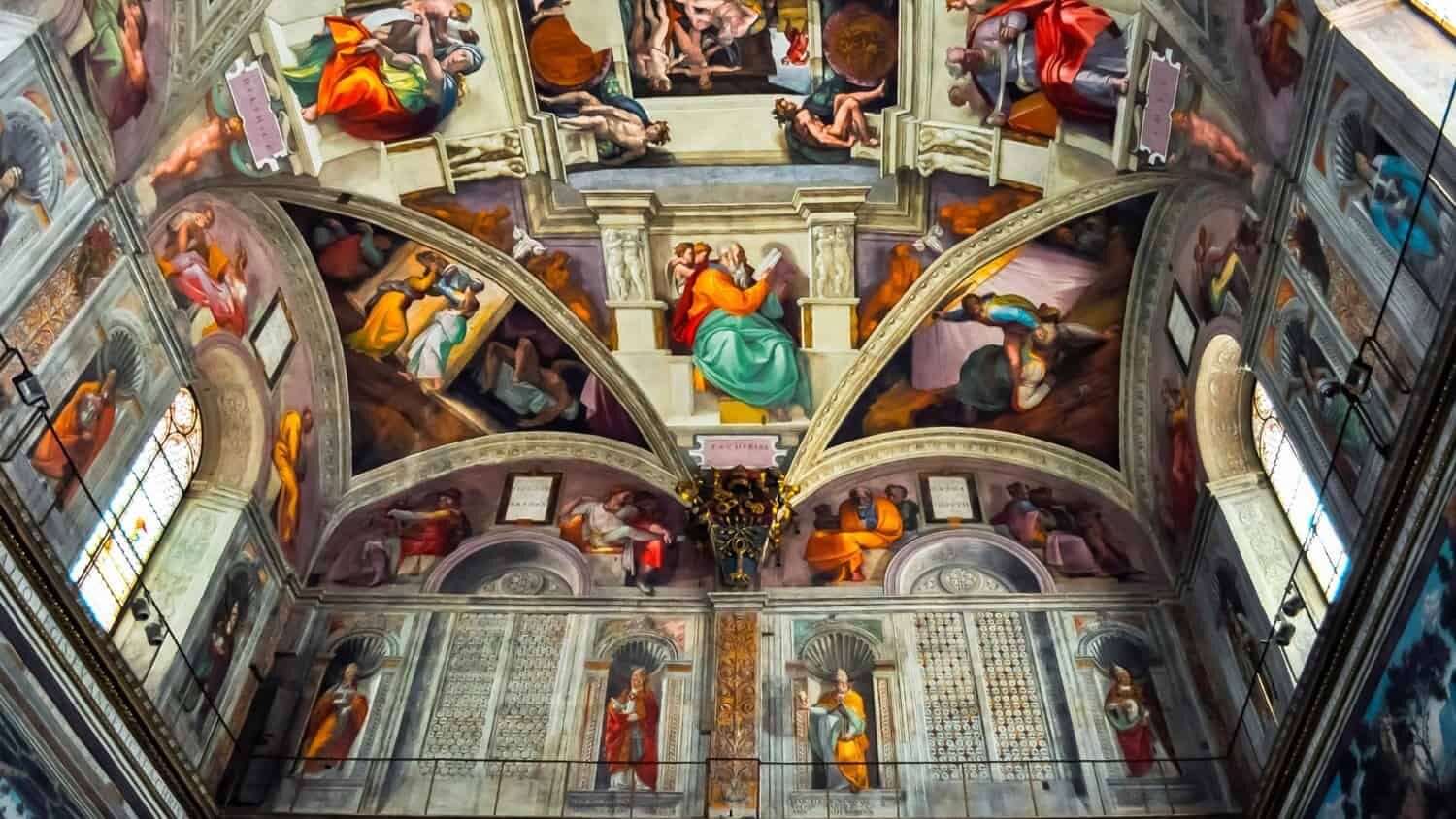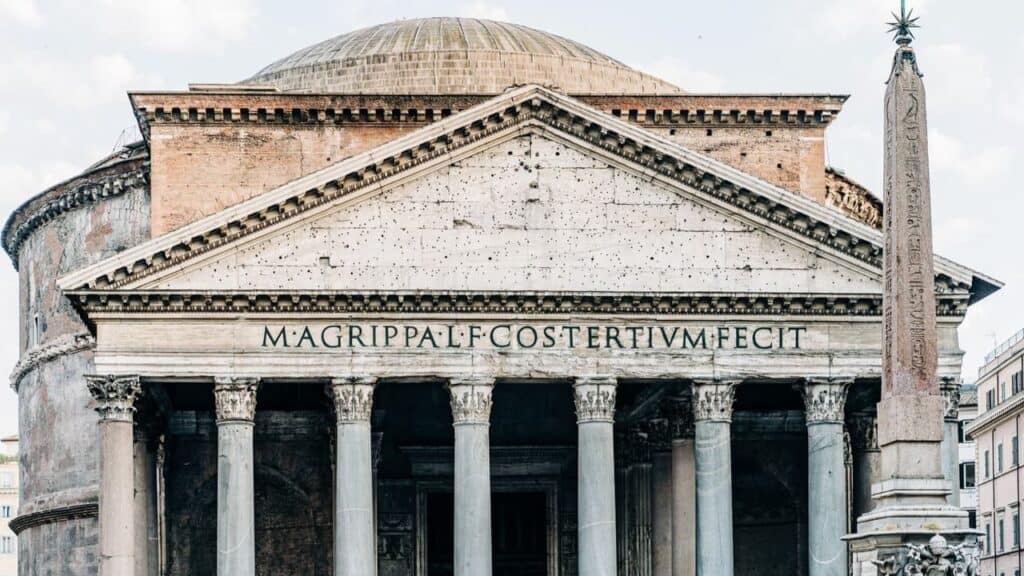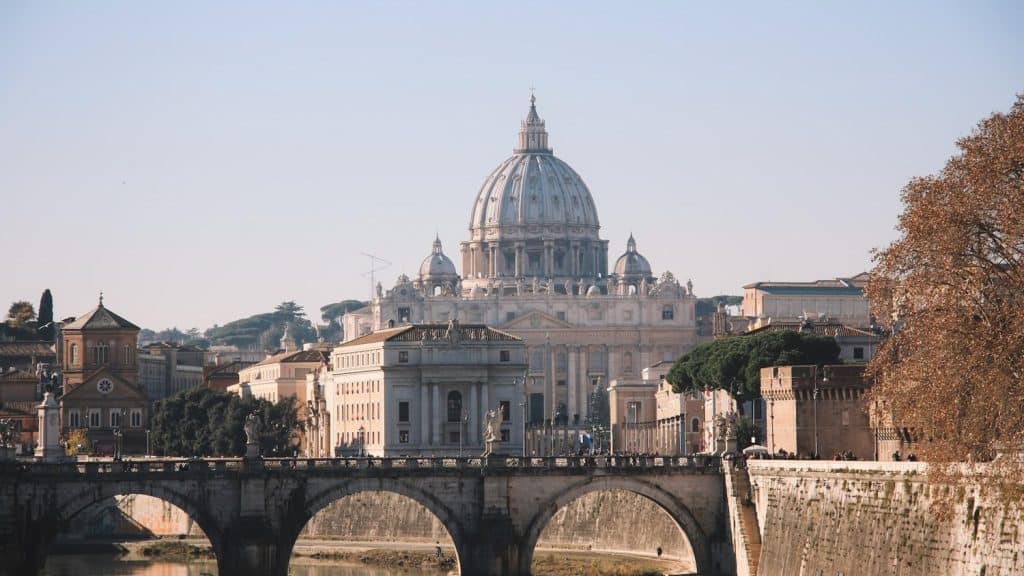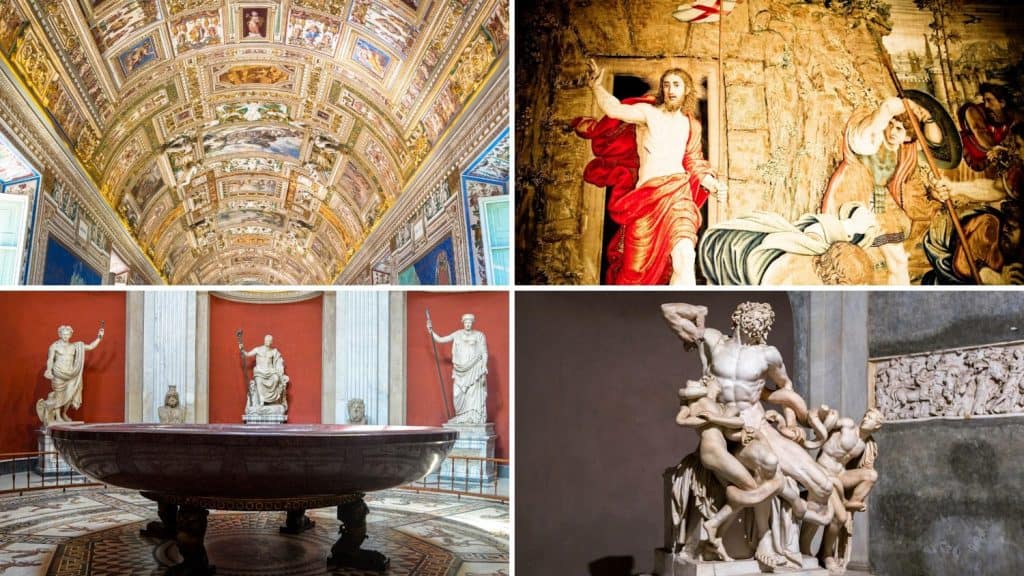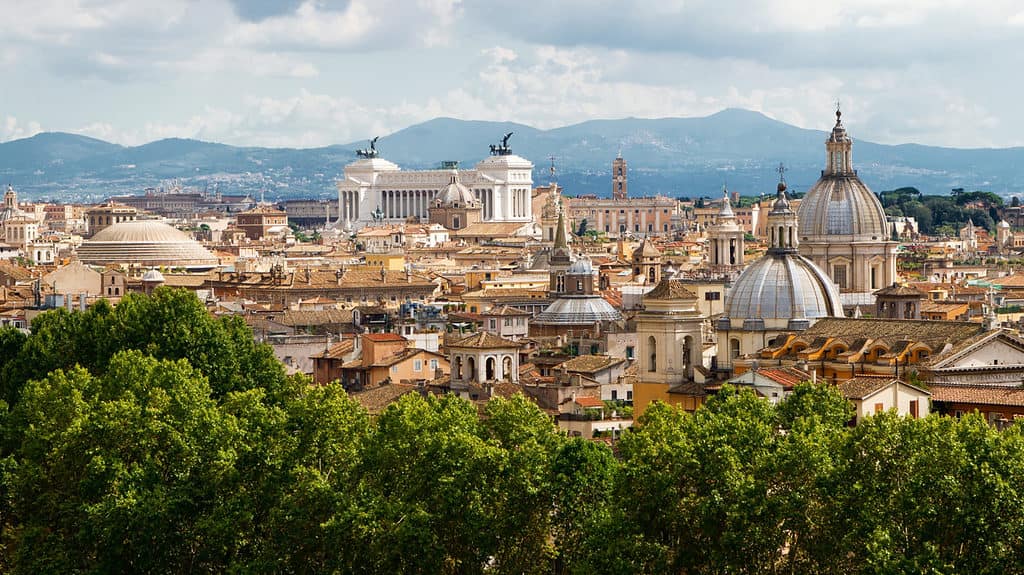Probably nowhere in the world you will find such a famous decorated interior as the Sistine Chapel . In this guide you will learn all about the Sistine Chapel – frescoes and paintings, entrance, where to buy tickets, what the opening hours are and when to visit the Sistine Chapel.
- Sistine Chapel
- Entrance
- Opening hours
- Tickets and admission
- When to visit the Sistine Chapel
- Tips before visiting
- Map of Vatican
We update admission fees, opening times and other useful information for the Vatican Museums and the Sistine Chapel several times a year. The latest update is always listed at the beginning of the article.
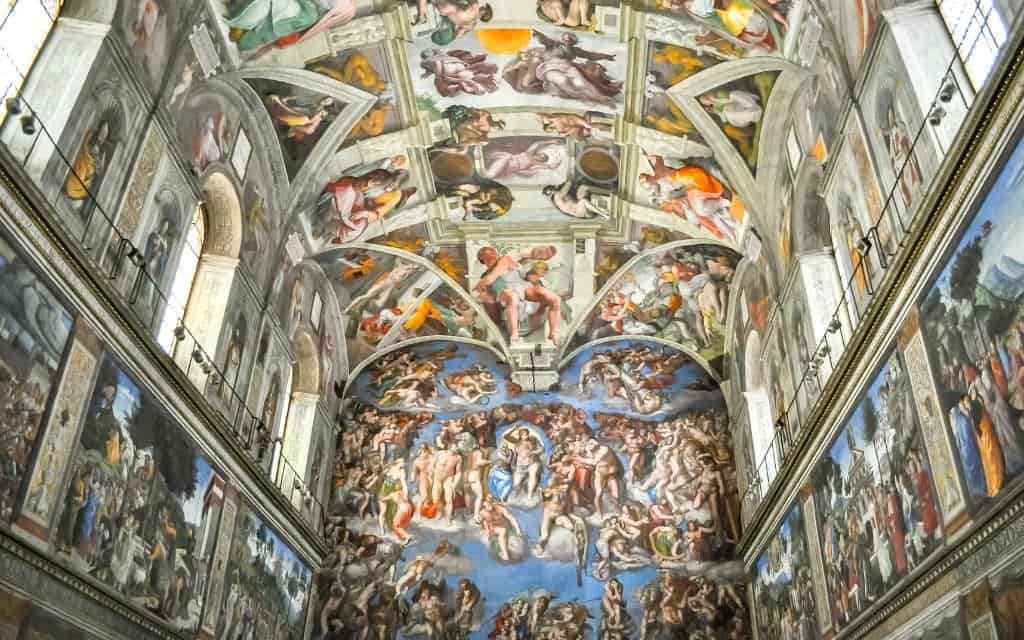
Sistine Chapel – a quick overview
Where is the Sistine Chapel?
The Sistine Chapel is part of the Vatican Museums. To visit it, you have to go through the Vatican Museums (at least the shorter route without the 2nd floor – I don’t recommend it, as you would miss the wonderful Raphael Rooms). The Sistine Chapel is directly connected to the museum and cannot be visited separately.
Admission to the Sistine Chapel
Admission to the Sistine Chapel varies depending on whether you buy your tickets at the door or in advance. Tickets are cheaper at the door – full admission is €20 and reduced admission is €8 (children over 6 and students under 26). Children up to 6 years of age and disabled children with disability over 74% are admitted free of charge.
You’ll pay more if you book in advance, but on the other hand you won’t be waiting in line and you’ll be sure to get in.
The ticket includes a visit to the Vatican Museums and the Sistine Chapel, two of the most popular places in the Vatican and Rome.
How to skip the queues for the Vatican Museums and the Sistine Chapel?
The Vatican Museums and the Sistine Chapel are famous for their queues.
The easiest way to skip the queues is to book tickets in advance. There are three separate lines at the venue – the ticket line on the left, the middle line if you have a reservation, and the line for guided tours on the right.
Even at the time of the biggest queue (see photo above), we didn’t wait for a reservation at all and went straight in.
What to do if tickets to the Vatican Museums and the Sistine Chapel are sold out?
A very common reality – tickets to the Vatican Museums can sell out weeks in advance. In this case I recommend a guided tour. There are several to choose from and plenty of dates available. This is an increasingly popular way to visit the Sistine Chapel.
Another option is to queue – arrive before opening hours to keep the queue to a minimum.
Sistine Chapel Attractions
The Sistine Chapel was built between 1473 and 1481 by Pope Sixtus IV, who named the chapel after himself. From that time until now, conclaves, or gatherings of cardinals, have been held here to vote on who will become the next Pope.
The exterior of the Sistine Chapel is not what attracts so many visitors. On the contrary, it looks inconspicuous from the outside and resembles a fortress.
What attracts 20,000 people a day are the beautiful frescoes above the ceiling and the painting above the altar. The chapel is over 40 m long, 13 m wide and 20 m high.
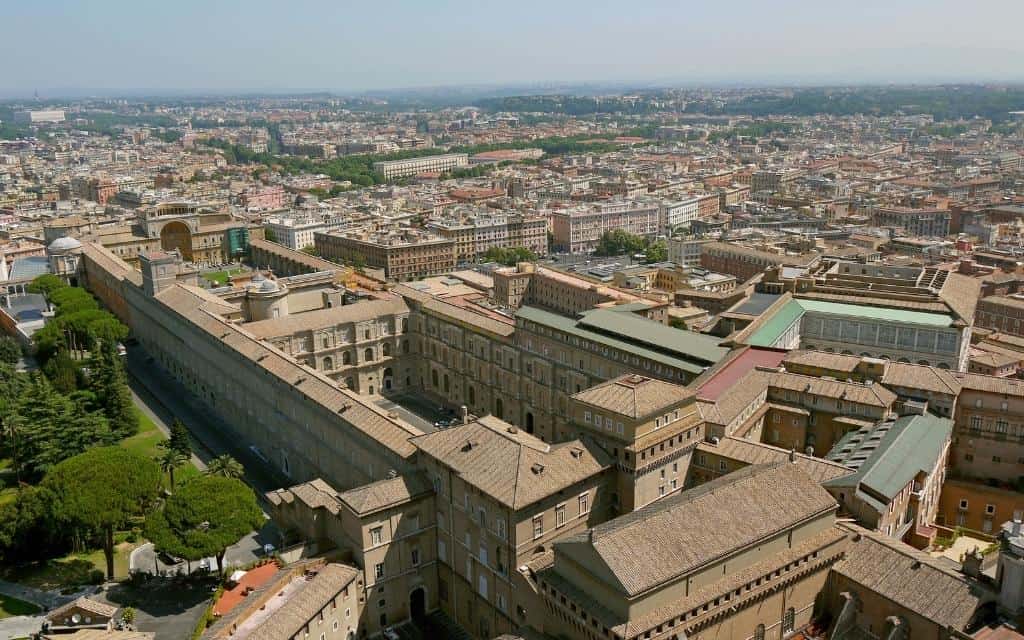
Frescoes on the ceiling
The frescoes on the ceiling by the Italian sculptor Michelangelo are the most famous paintings in the Sistine Chapel. Most visitors automatically turn their heads up upon arrival at the chapel. The frescoes depict scenes from the Old Testament and are full of naked male bodies, which Michelangelo represented were deities.
The whole ceiling seems to open to the sky. At its highest point stretches a central strip with 9 scenes from the book of Genesis, which follow each other from the altar wall chronologically according to the Bible. Each scene is framed by a frame that looks real, not just painted.
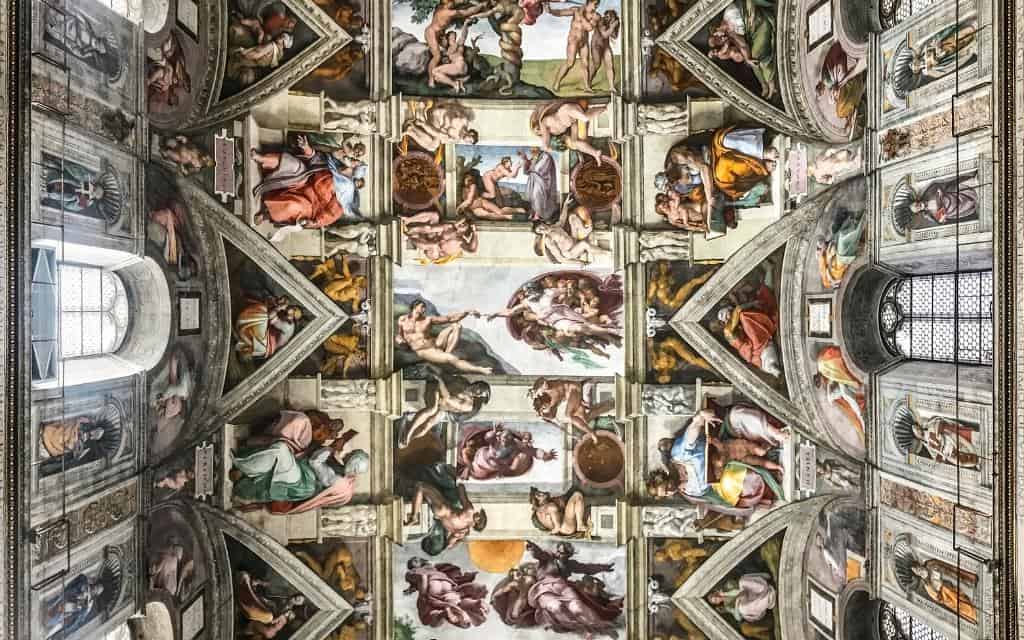
The original ceiling in the Sistine Chapel was blue with stars. It was not until 1508 that Pope Julius II called. Michelangelo of Florence to paint the ceiling of his private chapel, which serves as a conclave (new popes are elected here).
Michelangelo was not entirely thrilled because he was a sculptor and did not have much experience in organizing a painting project of this magnitude. In addition, he was working on the tomb of Julius II. In front of him, Raphael and Bramante received an offer to paint the Sistine Chapel, but they both refused.
Michelangelo began working on the frescoes at the age of 32 and completed them in just 4 years in 1512. During the course of his work he encountered many complications, often caused by his own less than warm behaviour. He had to build his own scaffolding, refused his assistants and painted everything standing up, so that the coloured pigments fell into his eyes.
In addition, he was forced to work very quickly precisely because of the technique of fresco painting, where he paints on wet plaster, so the painting must be finished before the plaster dries. The fresco in Italian means fresh . The most famous fresco on the ceiling of the Creation of Adam was therefore completed in just 9 days.
Michelangelo received 3,000 ducats for the roof frescoes, which equals $ 80,000 today.
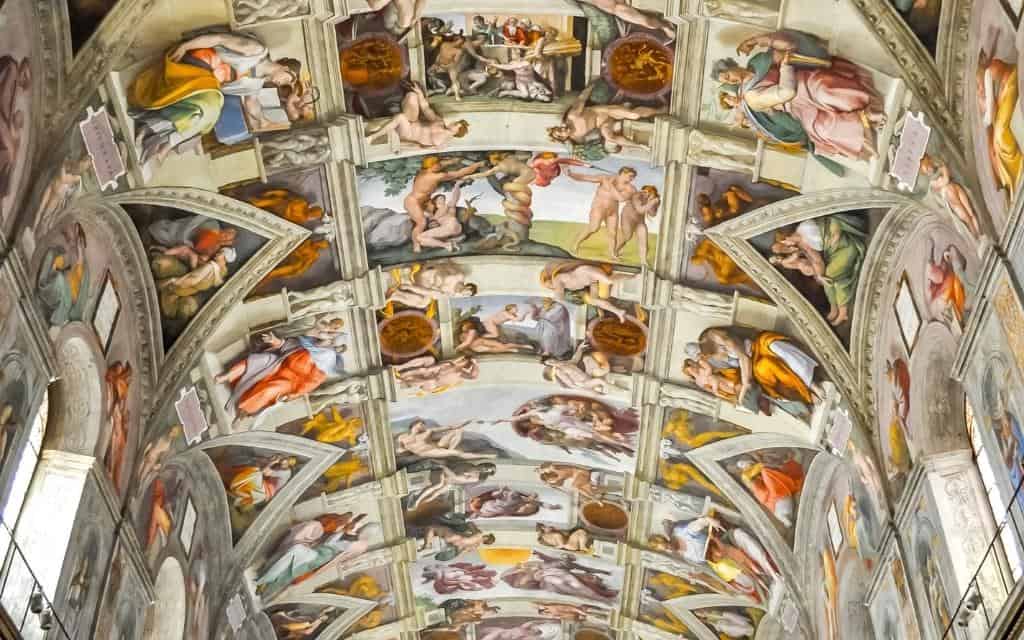
The Last Judgement
At the age of 61, Michelangelo was called back to the Vatican to paint the Last Judgment on the great wall behind the altar. The painting lasted him for 5 years and depicts the story of Christ who separated who will enter heaven and who will go to hell. In painting, Michelangelo used the extremely expensive pigment lapis lazuli from Afghanistan.
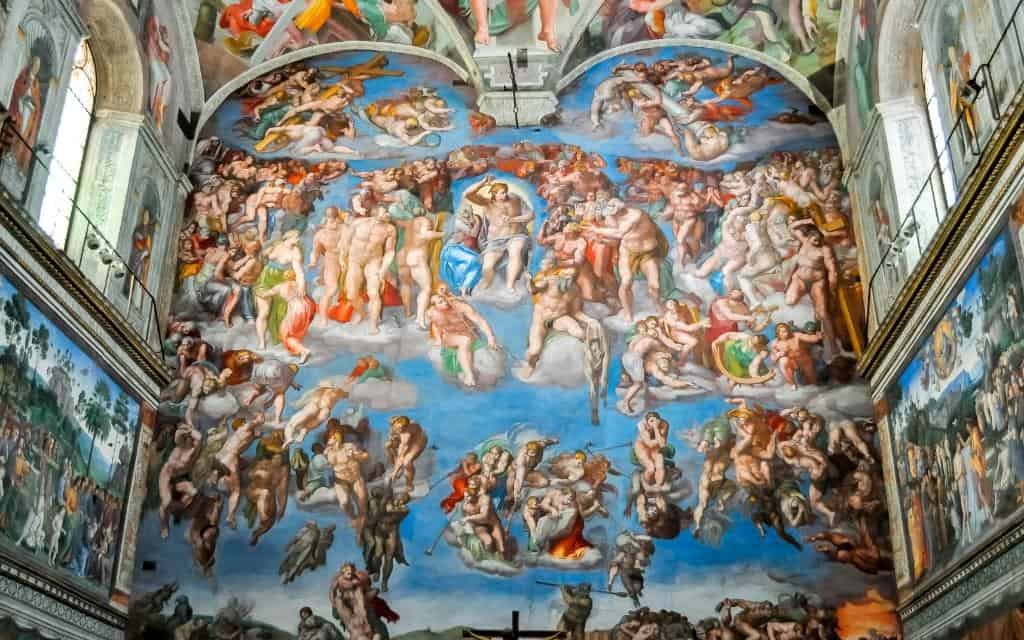
The pope’s ceremonialists did not like the amount of nudity on the fresco and even suggested that the wall belonged to the brothel rather than the Sistine Chapel. This angered Michelangelo so much that he painted the ceremonialist on the lower right side as an underworld judge with donkey ears and a snake wrapped around his neck.
A year later, after Michelangelo’s death, at the instigation of Pope Paul IV. the Italian painter Daniele da Volterra covered many of these figures with draped clothes, as we see today.
If you look at St. Bartholomew, who is sitting on a cloud in the middle of a painting, you will see that he is holding a knife towards Christ and at the same time holding his own skin. The knife represents the weapon with which he was martyred, and the face of the skin is not St. Bartholomew’s, but Michelangelo’s.
According to many, the artist showed how he felt for many years working for the church.
Pictures of Quattrocento
Michelangelo’s frescoes literally overshadowed paintings by other great artists . You’ve been here before. Pope Sixtus IV. after the completion of the Sistine Chapel, he called in the 5 greatest Florentine artists of the time, who were known as masters of the Quattrocentrum (Botticelli, Perugino, Pinturicchio, Ghirlandaio, Rosselli).
Their task was to paint the walls of the Sistine Chapel in their middle. On the north wall you will enjoy frescoes from the life of Christ and the south wall tells the life of Moses.
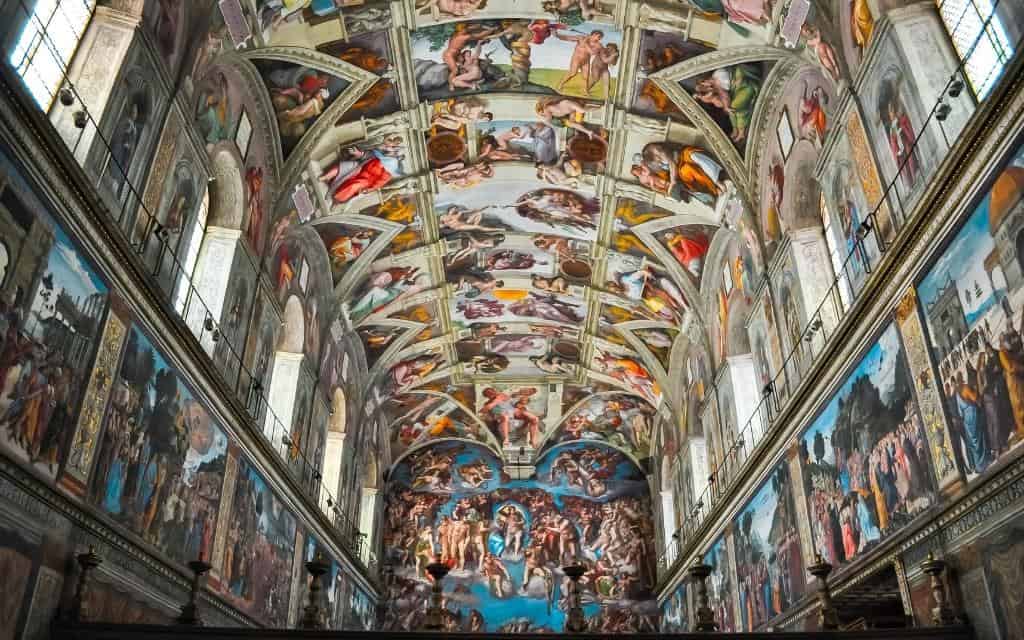
The frescoes of the Sistine Chapel passed at the end of the 20th century with extensive restoration that lasted 14 years. The restoration was financed by the Japanese television company Nippon in exchange for photo copyrights until 2019. That is why there was a ban on photography in the Sistine Chapel for years, which remained in force.
Entrance
The entrance to the Sistine Chapel is through the Vatican Museums. If you don’t stop anywhere in the museums and take the main route, you will walk to the Sistine Chapel in about half an hour. You cannot leave the Vatican Museums without visiting the Sistine Chapel.
The Sistine Chapel can be reached from Viale Vaticano, about 10 minutes from Ottaviano and Cipro Metro Stations (Metro Line A; with Roma Pass is free). You will come to the walls of the Vatican, where you will already see signs for the Vatican Museums.
The second option is to enter the Vatican from St Peter’s Square via St Peter’s Basilica. After a tour of the basilica, you continue along the wall 15 minutes to the entrance to the Vatican Museums and the Sistine Chapel.
Please note: On Wednesdays the Pope has an audience and the Basilica does not open until 12:30-13:00.
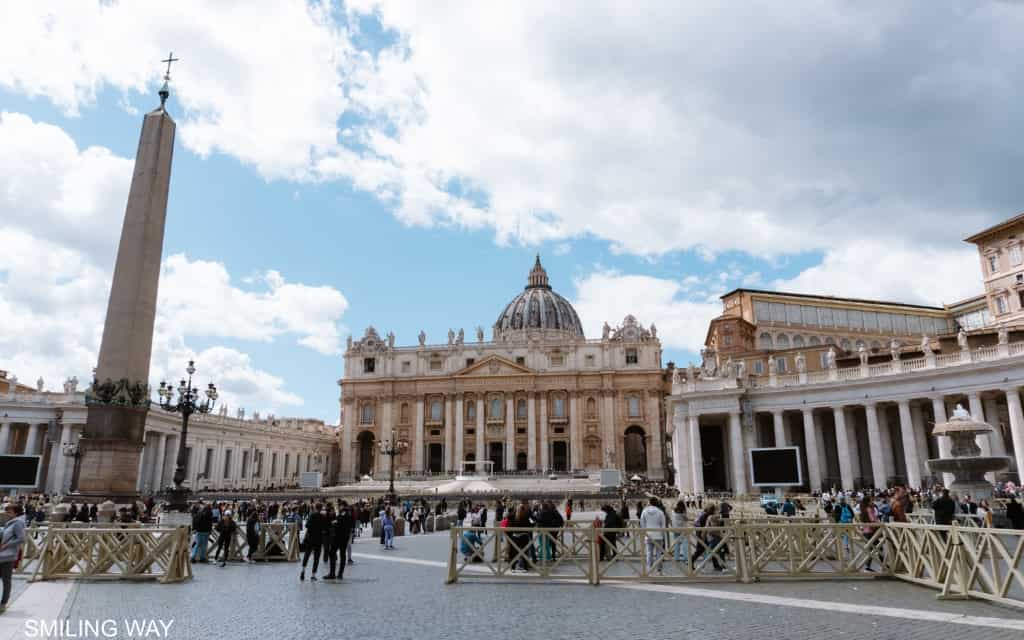
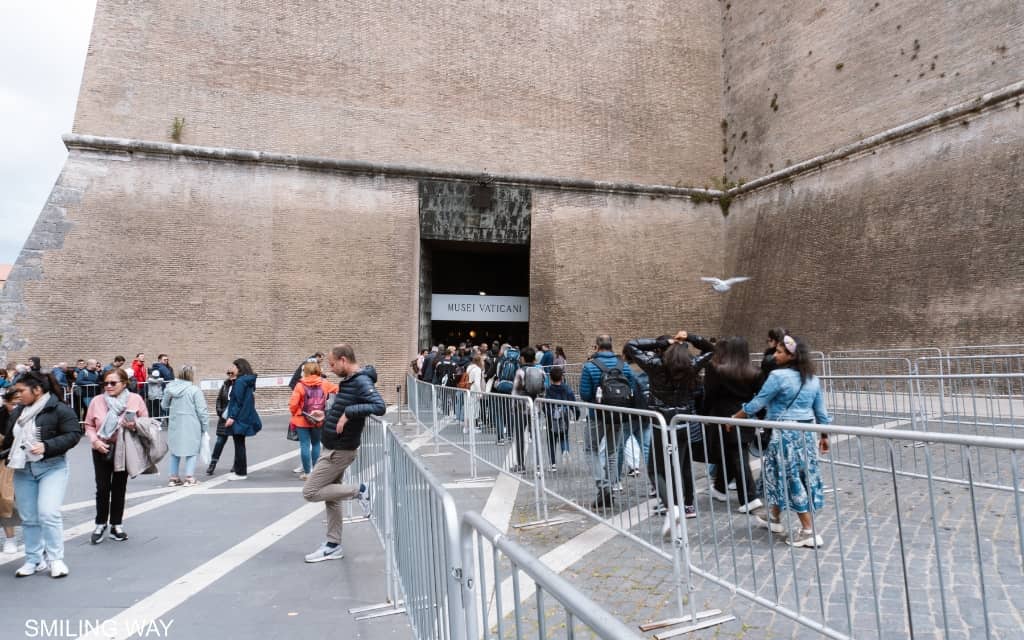
Opening hours 2024
Opening hours to the Sistine Chapel vary according to the season and coincide with the opening hours of the Vatican Museums.
The Vatican Museums are open Monday to Saturday from 8:00-19:00 (last entry at 17:00). Since March, the opening hours in the high season on Fridays and Saturdays are extended until 20:00 (last entry at 18:00).
Closed on Sundays except the last Sunday of the month when it is open 9:00-14:00 (last entry at 12:30).
When is the Sistine Chapel closed?
It is closed on all Sundays except the last one, when admission is free. The Sistine Chapel is also closed on Catholic holidays:
- 1st January
- January 6 at the Three Kings
- 31 March and 1. April for Easter
- May 1 to celebrate the workers
- June 29 on the feast of St. Peter and Paul
- 14th and 15th August for the celebration of the Assumption of the Virgin Mary
- November 1, All Saints’ Day
- 25 and 26 December for the celebration of the birth of Jesus Christ
Tickets and admission to the Sistine Chapel 2024
The Sistine Chapel is part of the Vatican Museums. Admission to the Sistine Chapel and the Vatican Museums is €20 and a reduced admission fee of €8 (for children 6-18 and students 19-26). Children up to 6 years of age and disabled children with disability over 74% are admitted free of charge.
Where to buy tickets to the Sistine Chapel? You can buy tickets on the spot, but be prepared for the long queues that the Vatican Museums and the Sistine Chapel are famous for – see photo above. Up to 30,000 people come here every day.
I recommend the tickets book online in advance for an additional fee (plus the option to skip the line).
In high season, book at least a few days to weeks in advance to avoid selling out.
You can also choose a guided tour.
You can book your tickets here:
When to visit the Sistine Chapel?
When visiting the Vatican Museums, everyone wants to see the Sistine Chapel. Sometimes it’s even the main reason why people come here. The only thing that follows is that it is often full and you move at a snail’s pace during the season.
The queues start right outside the entrance and it doesn’t matter whether you choose to enter via St Peter’s Basilica or from Viale Vaticano (the official entrance for the Vatican Museums).
So when is the best time to visit the Sistine Chapel? November, January, February and March until Easter are the quietest months with the smallest crowds. The main season begins in the Vatican after Easter and especially in the summer months (June, July, August) there is the greatest influx of tourists.
As for the time of day, I recommend visiting the Sistine Chapel as soon as possible after opening hours. If you have a reservation in advance, you can come in the afternoon and you won’t have to wait, but there will be a lot of people inside. Early in the morning you have a better chance of a quieter tour (and better air in the summer).
If you plan to visit the first basilica of St. Peter, you can go here at 7 o’clock, when it opens. There are no queues like this early in the morning.
Choose quieter days Tuesday, Thursday and Friday. It is full on Saturdays, Mondays and Wednesdays, when the Pope has an audience on St. Peter’s Square between 12 and 1 pm (in winter, in the hall to the left of the basilica).
Thousands of people will come to see the Pope, and many of them plan to visit St Peter’s Basilica and the Vatican Museums and the Sistine Chapel before or after.
I do not recommend visiting the Sistine Chapel on the last Sunday of the month. Admission is free, but queues can be several hours. If you want to save money with free admission, arrive at 8am at the most and get in line (museums open at 9am).
Tips before visiting
- There is a cafeteria in the Vatican Museums where you can eat, but to be honest, the food is not very good. I recommend eating beforehand, as you will spend a lot of time here and the tour can be exhausting.
- There is another point to this – take comfortable shoes. There’s a lot of walking around. If you go around everything, the route is 7.5 kilometers long.
- Photography is forbidden in the Sistine Chapel. You can take pictures in the Vatican Museums, but without a flash. It’s heavily guarded.
- Toilets are right at the entrance and exit and in several other places in the museum.
- Dress appropriately. Feel free to wear jeans and a T-shirt, but cover your knees, shoulders, abdomen, or take your hat off your head. Sometimes the control is milder and will let you in, even if you run into stricter control, you won’t get inside.
- The Vatican Museums and the Sistine Chapel are part of the Roma & Vatican Pass.
Map of Vatican
HOW TO USE THIS MAP: Above you will find a detailed map of Vatican. Click at the top left of the map to see separate layers with highlighted locations. You can hide and show the different layers or click on the icons on the map to show the names of the places I mention in the Sistine Chapel guide. If you want to save the map, star it. For a larger version, click on the icon in the upper right corner.
How to save in Rome on transport and admission?
It is very easy to save in Rome thanks to Roma Pass tourist card. With it, you get free admission to the most famous sights and reduced admission to many other places. The card also includes unlimited travel around Rome and the use of information points with public toilets and the possibility to get a phone (this is always useful in cities, what we will talk about).
These were our tips for visiting the Sistine Chapel. Do you have any questions? We’ll be happy to answer them in the comments below. Have a safe journey!
More about Rome
THE BEST PLACES TO VISIT IN ROME: In our article on what to visit in Rome, you will find detailed descriptions of the most beautiful places, including information on admission fees and opening times. We also have special guides for the monuments of ancient Rome or the best museums in Rome.
Read the guides for the Vatican Museums and the Colosseum to avoid queues on site. In the next article you can see 25 photos of the interiors of the Vatican Museums.
ITINERARY FOR ROME: Get inspired by our itinerary for Rome in 3 days. You only have one day? The itinerary for Rome in 1 day will help you plan the perfect trip.
ACCOMMODATION IN ROME: We’ve created a detailed guide on where to stay in Rome (best neighbourhoods and accommodation on a budget, a map and how to get from your accommodation to the sights or the airport).
HOW TO ENJOY ROME: For tips on the best things to do in Rome, check out our article on what in. We also share some tips on how to save in Rome and more than 35 tips for travelling around Rome. In a separate article, you can find out about all the ways to get from Fiumicino Airport to the centre of Rome.
Frequently asked questions about the Sistine Chapel
The Sistine Chapel is a chapel in the Vatican known for its beautiful frescoes inside. 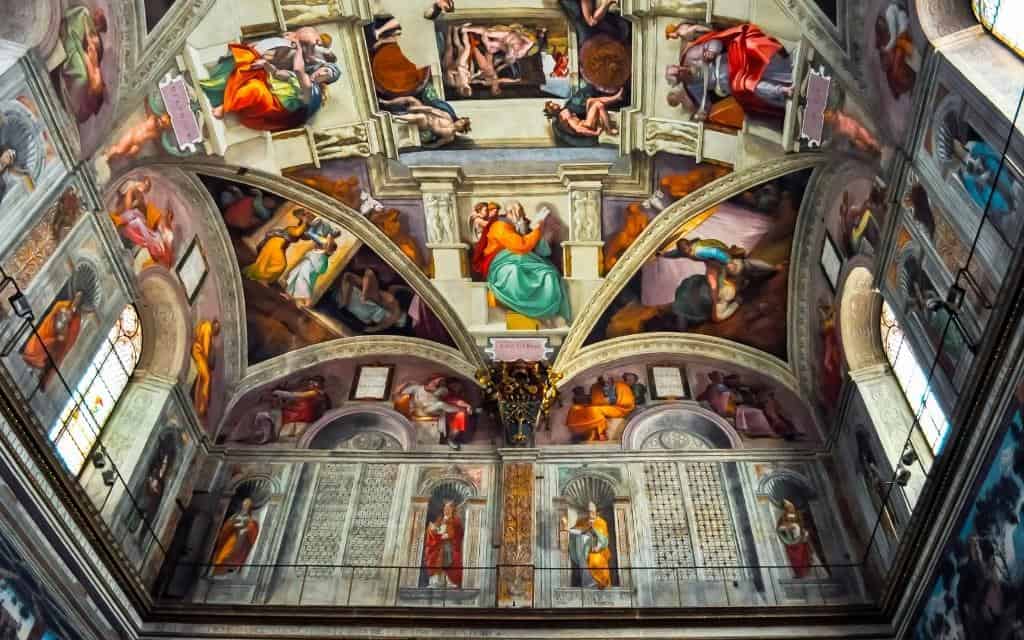
The Sistine Chapel is located in the Apostolic Palace in the Vatican, which is the official residence of the Pope.
Italian sculptor Michelangelo Buonarroti
Viale Vaticano 51, Vatican City
Metro – red line A → Cipro or Ottaviano stop
Opening hours to the Sistine Chapel vary according to the season and coincide with the opening hours of the Vatican Museums.
The Vatican Museums are open Monday to Saturday from 8:00-19:00 (last entry at 17:00). Since March, the opening hours in the high season on Fridays and Saturdays are extended until 20:00 (last entry at 18:00).
Closed on Sundays except the last Sunday of the month when it is open 9:00-14:00 (last entry at 12:30).
Admission to the Sistine Chapel is included in the admission to the Vatican Museums – full admission €20, reduced admission €8 (for children over 6 years and students 19-25 years inclusive); fee for online booking
You don’t have to, but in high season they can sell out days or weeks in advance.
